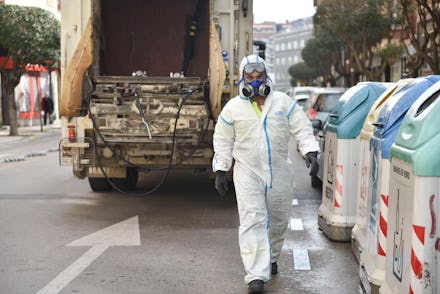Coronavirus is creating a staggering amount of medical waste

Hospitals around the world are doing everything in their power to protect the public against the coronavirus pandemic. You've likely seen the calls for more personal protective equipment to deal with sudden shortages — essentials including masks, gloves, and gowns that keep patients and practitioners alike safe. While the usage of this equipment is absolutely necessary, it also comes with an unfortunate aftermath: a massive amount of medical waste and potentially hazardous material.
While hospitals are essential operations, they are also particularly wasteful ones. According to Practice Greenhealth, as much as 29 pounds of waste can be produced from each staffed bed in a hospital every single day. The organization estimates that there are more than five million tons of medical waste produced by hospitals in the United States each year. The total amount is likely much higher when one accounts for home care and other practices like veterinary clinics and pharmacies. At this stage, it's unclear just how much additional medical waste will be produced across the US as a result of the coronavirus outbreak — disposal company Stericycle claims it has already recorded an increase — but if the experience of other nations is any indication, it's going to be a lot.
In Wuhan, China, hospitals produced six times as much garbage — generating 270 tons of it per day, as opposed to the 44 tons they produced prior to the outbreak, according to the energy and environment publication E&E News. In response, the Chinese government constructed a new medical waste plant, rolled out 46 mobile waste treatment facilities, and repurposed hazardous waste facilities to deal with the influx.
Thus far, the US has not been overwhelmed in the same way. Julie K. Moyle, a staff nurse at Avista Adventist Ambulatory Surgery Center in Boulder, Colorado and engagement manager at sustainable healthcare firm Practice Greenhealth, tells Mic that "the handling of waste from COVID-19 patients does not present any new challenges in terms of segregation." The Centers for Disease Control and Prevention recommends that hospitals treat waste from COVID-19 patients the same way they treat regular medical waste. That typically means sterilizing or disinfecting it before sending it to a landfill or, less frequently, incinerating it.
Of course, the potentially hazardous and infected waste isn't just coming from hospitals. It’s also coming from the homes of people who have been infected or exposed to the virus. According to a study published in the New England Journal of Medicine, the virus can live on cardboard for up to a full day, and can last even longer on metal or plastic — up to 72 hours. This may require extra precautions from sanitation workers in order to ensure they don't accidentally come into contact with contaminated trash. The World Health Organization (WHO) recommends those dealing with the potential virus-carrying garbage wear boots, long sleeves, gloves, and goggles or face shields when handling the waste. It's also important that people properly bag their trash so that sanitation workers don't have to interact with it directly. Thus far, according to WHO, proper precautions have paid off. “There is no evidence that direct, unprotected human contact during the handling of health care waste has resulted in the transmission of the COVID-19 virus,” the organization said in a technical brief published earlier this month.
While waste from dealing with the COVID-19 outbreak is largely inevitable, the situation does present an opportunity to rethink some of the less sustainable practices that hospitals have used for years — particularly when it comes to operating rooms. According to Practice Greenhealth, operating rooms account for about 30 percent of all supplies for an entire hospital. By making some simple changes like improving fluid management programs, repurposing unused tools, and adapting medical device reprocessing practices, Practice Greenhealth estimates that hospitals can save $25,000 per operating room each year. It would also help to reduce the environmental footprint of hospitals, which make up about eight percent of all greenhouse gas emissions in the US. "With the pause in elective surgeries, now may be a good time to evaluate recommended environmental practices in the operating suite," Moyle tells Mic. "There are big dollar savings opportunities, which will be needed in the aftermath of the pandemic, and facilities might consider upstream waste reduction opportunities."
Some of these improved practices could be implemented throughout the hospital once the coronavirus outbreak is contained. According to a study from the University of Illinois-Chicago's school of public health, the healthcare industry as a whole could save $5.4 billion in five years and up to $15 billion over the course of a decade simply by adopting improved sustainability practices. That includes improved segregation processes to separate medical waste, recycling initiatives that cut back on the amount of waste sent to landfills, more efficient purchasing processes when stocking operating room supplies and a shift to using reprocessed devices rather than single-use ones. The middle of a pandemic may not seem like the ideal time to hit the reset button on waste management, but laying the groundwork now could lessen the overall impact of waste during normal operations.